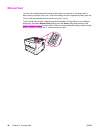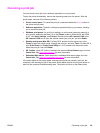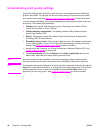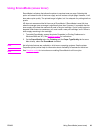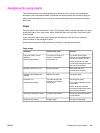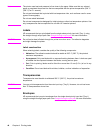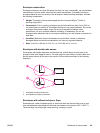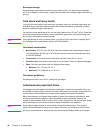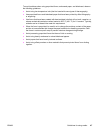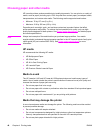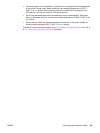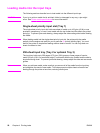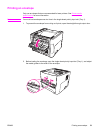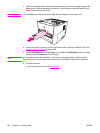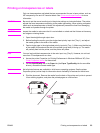
Envelope storage
Proper storage of envelopes contributes to good print quality. You should store envelopes
flat. If air is trapped in an envelope, creating an air bubble, the envelope might wrinkle during
printing.
Card stock and heavy media
You can print many types of card stock from the paper input tray, including index cards and
postcards. Some card stock performs better than others because its construction is better
suited for feeding through a laser printer.
For optimum printer performance, do not use paper heavier than 157 g/m
2
(42 lb). Paper that
is too heavy might cause misfeeds, stacking problems, paper jams, poor toner fusing, poor
print quality, or excessive mechanical wear.
Note
You might be able to print on heavier paper if you do not fill the input tray to capacity and if
you use paper with a smoothness rating of 100-180 Sheffield.
Card stock construction
●
Smoothness: 135-157 g/m
2
(36-42 lb) card stock should have a smoothness rating of
100-180 Sheffield. 60-135 g/m
2
(16-36 lb) card stock should have a smoothness rating
of 100-250 Sheffield.
● Construction: Card stock should lie flat with less than 5 mm (0.2 in.) of curl.
● Condition: Make sure that the card stock is not wrinkled, nicked, or otherwise damaged.
● Sizes: Only use card stock within the following size ranges:
● Minimum: 76 x 127 mm (3 x 5 in.)
● Maximum: 216 x 356 mm (8.5 x 14.0 in.)
Card stock guidelines
Set margins at least 2 mm (0.08 in.) away from the edges.
Letterhead and preprinted forms
Letterhead is premium paper that often has a watermark, sometimes uses cotton fiber, and
is available in a wide range of colors and finishes with matching envelopes. Preprinted forms
can be made of a broad spectrum of paper types ranging from recycled to premium.
Many manufacturers now design these grades of paper with properties optimized for laser
printing and advertise the paper as laser compatible or laser guaranteed. Some of the
rougher surface finishes, such as cockle, laid, or linen, might require the special fuser modes
that are available on some printer models to achieve adequate toner adhesion.
Note
Some page-to-page variation is normal when printing with laser printers. This variation
cannot be observed when printing on plain paper. However, this variation is obvious when
printing on preprinted forms because the lines and boxes are already placed on the page.
46 Chapter 4 Printing tasks ENWW



